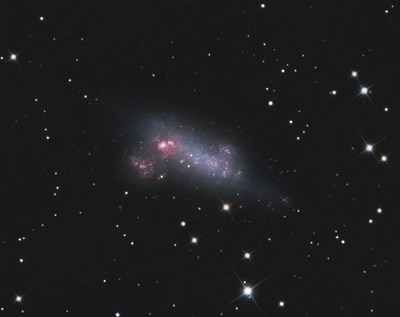
RA: 07h 28m Dec: +69º 12' Mag: 11.9, Size: ~20,000 ly, Distance: 12 mly

RA: 07h 28m Dec: +69º 12' Mag: 11.9, Size: ~20,000 ly, Distance: 12 mly
NGC 2366 is a faint irregular galaxy located in the constellation Camelopardalis and it part of the M81 group. This is considered a Magellanic galaxy due to its shape and dense star population that make it similar in appearance to the Large Magellanic and Small Magellanic Clouds located close to our own galaxy. With a size of twice that of the Large Magellanic Cloud, NGC 2366 is still classified as a dwarf. Located within the galaxy are the large star forming regions of NGC 2363. These dense H II areas of glowing hydrogen gasses are birth places of new stars. Contained within NGC 2363 is a rare Luminous Blue Variable star with a mass between 30 to 60 times that of the sun discovered by the HST in 1996. Comparing to previous images this star has increased 40 times brighter in three years. Star ages in this area range from 2 to 5 million years. Smaller H II areas can be seen throughout the galaxy body where active star formations are taking place. The blue glow from the body is in indication of the population of young stars.
| Location & Date |
Backyard, Abbott Observatory - March & April, 2010 Temperature - Low 40's F |
| Telescope | Deep Sky Instruments RC10C , F/7.3, Losmandy G11 Gemini, Prime Focus, Image scale 0.82 arcsec/pixel |
| Camera |
SBIG ST-2000XM w/CFW8, AO8 Baader LRGB AR Filters CCD temp -15°C |
| Exposure Times | (Ha) 12x15 (L) 45x15 (R) 14x15 (G) 14x15 (B) 14x15 Minutes, Bin 1x1 |
| Other Information |
Image planning - CCD Navigator Image acquisition/focus/guiding/dither - CCD Autopilot4 w/CCDSoft/TheSky6/PinPoint |
| Image Processing |
* Images Plus 3.75- Calibration, Normalize, Grade, Alignment, Sigma Avg. Combine, Deconvolution, Mild DDP * Adobe CS4 - Ha+L+RGB combine, Levels, Curves, Sharpening (@ 400X upscaled size), Cropping, NR, JPEG conversion |